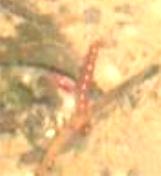
In a pond the small reddish larvae can sometimes be seen standing erect in the silt.
Midge is a name given to numerous minute species of flying, biting insects. The one which causes most problems is the Highland Midge, Culicoides impunctatus , which is thought to cause about 90% of bites. For such a small creature (usually a few millimetres long) they cause a great deal of suffering.
Midges are attracted by the carbon dioxide (CO2) exhaled by all animals and are thought to be able to detect it from 200 metres away. Activity is mainly at dusk or dawn, but they can also be present during daylight hours in the shade among trees and in dull weather. Could patio heaters be attracting them as they emit CO2? So as well as contributing to global warming they could be helping to put the dampers on evening entertainment alfresco, by attracting swarms of midges!
They are found in damp places where there are suitable sites for breeding. The larvae are detritovores, feeding on dead plant material in wet peat or in the silt in lakes and ponds, so they are an important part of the cycle which breaks down this debris. The adults are also an important food source for birds and bats, so unfortunately complete eradication is not an option.
A species of midge is also important to everybody who likes chocolate as it pollinates the flowers of the tropical tree that produces the cacao bean which is fermented to make the basic ingredient. Unfortunately the felling of forests to satisfy our demand for the delicious confection is damaging the habitat for the midge, the population is deminishing, pollination has greatly reduced and the drive to increase production is having the opposite effect.
The females must feed on blood to ensure that the eggs they lay will survive. In doing so they inject some saliva and this causes an allergic reaction which can vary in intensity for different individuals. They also release a pheremone to inform others that a blood source is present.
There are two batches of eggs laid in a season. The first is larger in number, but does not require the blood meal, so it is the second batch produced in late summer and autumn which leads to the biting frenzy. The first instar larvae which hatch, burrow into the moist ground and after three more instars emerge to increase the population greatly. The adult females from this generation do all the biting and the larvae they give rise to spend the winter underground to emerge as the adults of the following spring.
Midges can carry a notifiable viral disease known as Bluetongue which affects ruminant animals such as sheep, cattle and deer. It does not affect humans. The disease causes excessive production of saliva, swelling of the face and tongue which also becomes cyanotic, making it turn blue; the joints can also become swollen. Sheep are the most affected with about 70% fatalities and the survivors can be severely debilitated. Other ruminants may not show symptoms, but are capable of transmitting it when bitten by a midge which will carry it to its next host.
It was originally found in Africa where it is endemic, but has been moving northward and has moved to Mainland Europe in the last decade where it can be transmitted by other Culicoid midge species than the one in Africa. It was thought that the English Channel and North Sea would act as barriers to its progress. However, in September 2007, some cases have been found in Suffolk, possibly caused by some midges carried in the wind. It does not usually thrive at lower temperatures, but global warming has changed the potential regions for outbreaks to manifest.
They can also carry Myxomatosis which infects rabbits.
Treatments
Over the years there have been many potions devised to repel the onslaught of the midges. However as they are attracted by exhaled CO2 many of them are of limited or no effect.
|
|